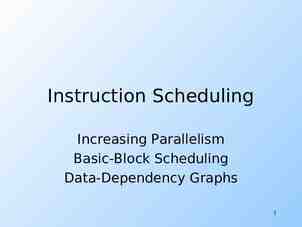5 Why’s Overview
14 Slides343.50 KB
5 Why’s Overview
Five Why’s Preparation Five why’s is a Root Cause Analysis Tool. Not a problem solving technique. The outcome of a 5 Why’s analysis is one or several root causes that ultimately identify the reason why a problem was originated. There are other similar tools as the ones mentioned below that can be used simultaneously with the 5 Why’s to enhance the thought process and analysis. Problem Root Cause Root Cause analysis Tools: Ishikawa Charts (Fish Bone) Design of Experiments Is / Is not Analysis 5 Why’s Cause & Effect Diagram. Statistical Data Analysis (Cpk, Paretto Charts, Anova,etc ) Corrective Actions
Five Why’s Preparation Any 5 Why’s must address two different problems at the same time. The first part is related to the process that made the defective part. (“Why made?”) The second one must address the detection system that was not able to detect the defective part before it became a problem. The lack of detection of a defective product is a problem of its own and must be treated independently than the product problem itself. (“Why not detected?”)
Five Why’s Preparation Even though the discipline is called 5 Why’s is not always necessary to reach 5 before the root cause of a problem is fully explained; or it may take more than 5 why’s to get to the bottom of it. It will depend on the complexity of the process or the problem itself. In any case, 5 has been determined, as a rule of thumb, as the number at which most root causes are clearly identified. Do not worry about not meeting or exceeding this number though. Just follow your thought process and let it decide how many Why’s you require to get to the point where the root cause is evident.
For all the Five Why’s: Ask the full question including the problem or cause behind it. If there is a problem with labeling ask: “Why the parts were labeled incorrectly?” If the answer is unreliable database ask: “Why is the database unreliable?” If we do not follow this approach answers to the why’s tend to lose focus on the third or fourth why.
Five Why’s Preparation It is said that a well defined problem is a half resolved problem; hence it is important to state the problem as clearly as possible. Whenever possible define the problem in terms of the requirements that are not being met. This will add a reference to the condition that should be and is not.
Five Why’s – The First Why Clear statement of the reason for the defect or failure to occur, understood even by people that is not familiar with the operation where the problem took place. Often this 1st Why must be a short, concise sentence that plainly explains the reason. Do not try to justify it, there will be time to do that later on in the following why’s if it is pertinent to the thought process. It is Okay to write it down even if it seems too obvious for you. (It may not seem that obvious to other persons that will read the document).
Five Why’s – The Second Why A more concise explanation to support the first statement. Get into the technical arena, the explanation can branch out to several different root causes here. It is OK to follow each of them continuing with their own set of remaining 3 why’s and so forth.
Five Why’s – The Third Why Do not jump to conclusions yet, follow the regular thought process even though some underlying root causes may start surfacing already. This 3rd why is critical for a successful transition between the obvious and the not so obvious. The first two why’s have prepared you to focus on the area where the problem could have been originated; the last three why’s will take you to a deeper comprehension of the problem. Visualize the process where the product went through (process mapping) and narrow down the most likely sources for the problem to occur. You do not need to answer all the why’s at the same time, it is an investigation activity and it will sometimes require you to go to the process and see things you could have missed at first. You may be missing the obvious by rushing into “logical” explanations”.
Five Why’s – The Fourth Why Clear your mind from preconceived explanations and start the fourth why with a candid approach. You may have two or more different avenues to explore now, explore them all. Even if one or several of them turn out not to be the root cause of the problem, they may lead to continuous improvements. This is a good time to include a Cause and Effect analysis and look at the 5 M’s. Method Materials Manning Machines Mother Nature
Five Why’s – The Fifth Why When you finally get to the fifth why, it is likely that you have found a systemic cause. Most of the problems in the process can be traced to them. Even a malfunctioning machine can sometimes be caused by an incorrectly followed Preventive Maintenance or Incorrect machine parameters setup. When you address a systemic cause, do it across the entire process and detect areas that may be under the same situation even if there are no reported issues yet. If you have reached the fifth why and you are still dealing with process related cause(s), you may still need one or two more why’s to deep dive into the systemic cause.
Five Why’s – Conclusion A good way to identify if the 5 Why’s was done properly is to try to organize the collected data in one sentence and define it in an understandable manner. If this cannot be done or the sentence is fragmented or meaningless chances are that there is gap between one or several of the why’s. You then must revisit the 5 Why and identify those gaps to fill them in. If there is coherence in the way that the sentence is assembled, it shows consistency on the thought process. Something like: “Problem Description” occurred due to “Fifth Why”. This was caused by “Fourth why” mainly because “Third Why” was allowed by “Second why”, and this led to “First Why”.
Five Why’s – Conclusion Do not forget that the sought outcome of a 5 Why exercise is a root cause of a the defined problem, not the resolution of the problem itself; that will come later. 5 Why’s is not a standalone Problem Solving technique but more of a tool to aid in this process. Do not worry about Action plans and effectiveness verification yet as that will be addressed in the 8D; but focus more on identifying the reason that allowed the problem to happen and escape. If you can come up with a reasonable answer, the 5 Why’s exercise would be successful. If it cannot be done, then quite probably more data needs to be collected to get a better grip of the problem and then the 5 Why process can be restarted.
Five Why’s – Conclusion One final point to ponder: A PROBLEM THAT CANNOT BE REPRODUCED IS A PROBLEM THAT HAS NOT BEEN RESOLVED YET. Challenge the root cause(s) that resulted from the 5 Why’s exercise to try to reproduce the defect. If you cannot there is a very big chance that you have not gotten to the bottom of it yet. If you do reproduce them, move on to the Corrective Action part and congratulate your team for a job well done.



















